Northeast Atlantic Ocean (40W)
Type of resources
Available actions
Topics
INSPIRE themes
Keywords
Contact for the resource
Provided by
Years
Formats
Representation types
Update frequencies
status
Scale
Resolution
-

This dataset represents the Network of Marine Protected Areas within OSPAR (Convention for the Protection of the marine Environment of the North-East Atlantic). MPAs are understood as areas for which protective, conservation, restorative or precautionary measures have been instituted for the purpose of protecting and conserving species, habitats, ecosystems or ecological processes of the marine environment. ------ Abstract derived from the abstract provided together with the dataset.
-
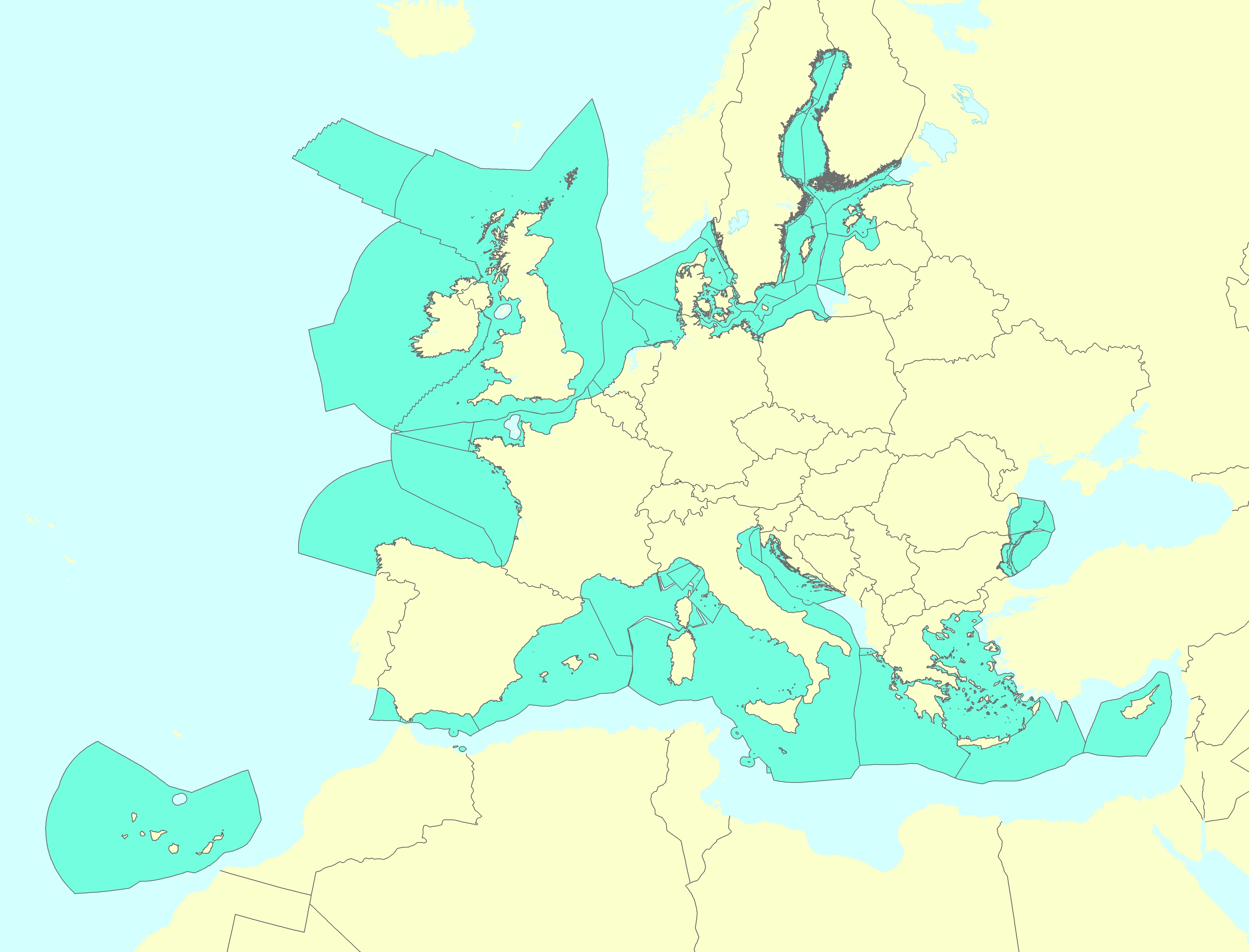
The Marine Reporting Units (MRUs) are used within the reporting obligations of the Marine Strategy Framework Directive (MSFD) in order to link the implementation of the different articles to specific marine areas. The MRUs can be of varying sizes, according to the appropriate scale for the different reports (e.g. region, sub-region, regional or sub-regional subdivision, Member State marine waters, WFD coastal waters, etc.), as indicated in the Good Environmental Status 2017 Decision. The present data set is the first public version released of the MRUs used during the first cycle of implementation of the MSFD (2012-2018) in all the reporting exercises (2012 reporting of Articles 8, 9 and 10; 2014 reporting of Article 11; and 2016 reporting of Articles 13 & 14). The data set is distributed in SHP and in INSPIRE-compliant GML format.
-
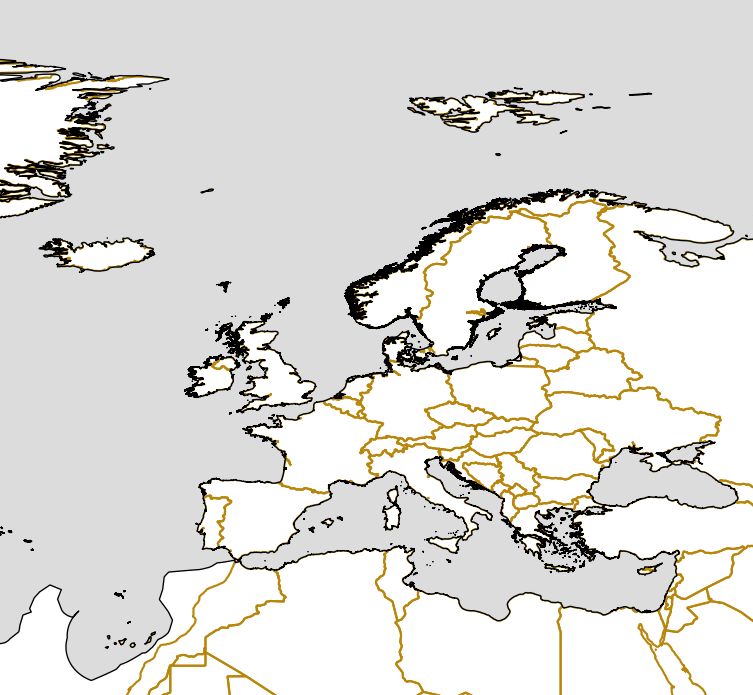
In the Marine Strategy Framework Directive - MSFD (Directive 2008/56/EC of the European Parliament and of the Council of 17 June 2008 establishing a framework for community action in the field of marine environmental policy), the following four marine regions are listed (art. 4): Baltic Sea, North-east Atlantic Ocean, Mediterranean Sea and the Black Sea. The present layer provides the spatial extent of these regions, as agreed by the MSFD Committee in November 2016.
-
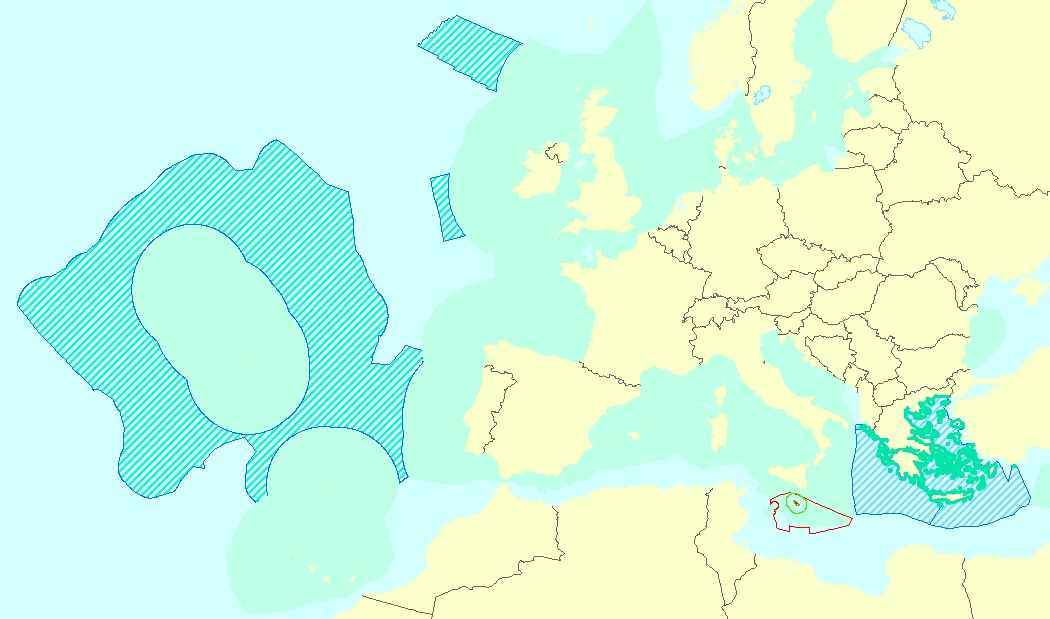
This vector data set is the first public version released of the EU marine waters used for the implementation of the Marine Strategy Framework Directive (MSFD), submitted by the Member States to the European Commission. The Marine Strategy Framework Directive (MSFD) applies to all marine waters of EU Member States, which in Article 3 are defined as follows: (a) waters, the seabed and subsoil on the seaward side of the baseline from which the extent of territorial waters is measured extending to the outmost reach of the area where a Member State has and/or exercises jurisdictional rights, in accordance with the UNCLOS, with the exception of waters adjacent to the countries and territories mentioned in Annex II to the Treaty and the French Overseas Departments and Collectivities; and (b) coastal waters as defined by Directive 2000/60/EC, their seabed and their subsoil, in so far as particular aspects of the environmental status of the marine environment are not already addressed through that Directive or other Community legislation.
-

In the Marine Strategy Framework Directive - MSFD (Directive 2008/56/EC of the European Parliament and of the Council of 17 June 2008 establishing a framework for community action in the field of marine environmental policy), the following four marine regions are listed (art. 4): Baltic Sea, North-east Atlantic Ocean, Mediterranean Sea and the Black Sea. The present layer provides the spatial extent of these regions, as agreed by the MSFD Committee in November 2016.
-
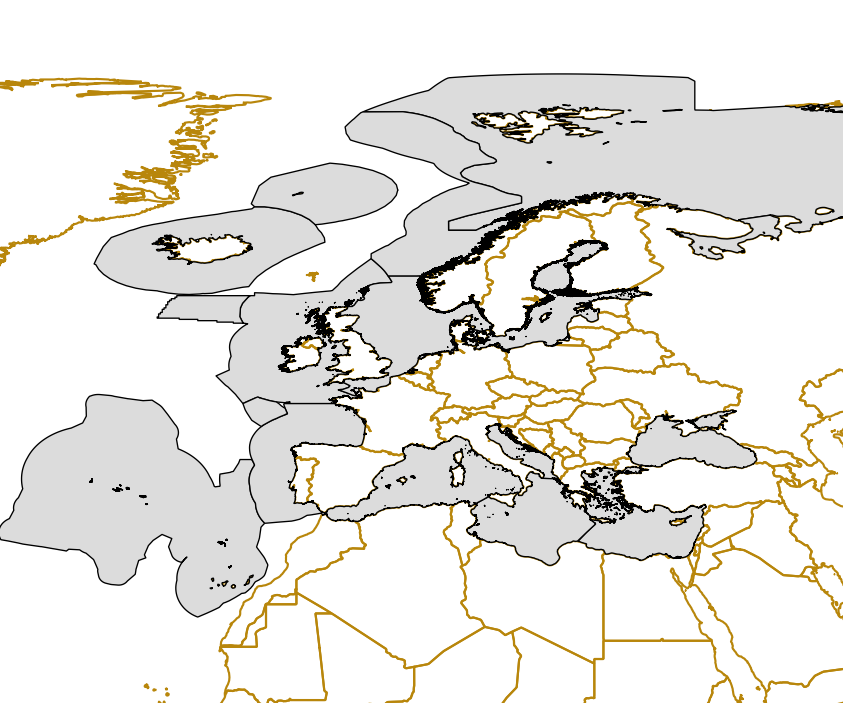
In the Marine Strategy Framework Directive - MSFD (Directive 2008/56/EC of the European Parliament and of the Council of 17 June 2008 establishing a framework for community action in the field of marine environmental policy), four marine regions are listed (art. 4): Baltic Sea, North-east Atlantic Ocean, Mediterranean Sea and the Black Sea, among which two are further divided into four subregions each. Apart of these, other relevant seas are also surrounding Europe. The present layer provides the spatial extent of the Europe seas, including those regions and subregions mentioned in the MSFD.
-

In the Marine Strategy Framework Directive - MSFD (Directive 2008/56/EC of the European Parliament and of the Council of 17 June 2008 establishing a framework for community action in the field of marine environmental policy), four marine regions are listed (art. 4): Baltic Sea, North-east Atlantic Ocean, Mediterranean Sea and the Black Sea, among which the following two are further divided into four subregions each: North-east Atlantic Ocean: o The Greater North Sea, including the Kattegat and the English Channel o The Celtic Seas o The Bay of Biscay and the Iberian Coast o Macaronesia Mediterranean Sea: o The Western Mediterranean Sea o The Adriatic Sea o The Ionian Sea and the Central Mediterranean Sea o The Aegean-Levantine Sea The present layer provides the spatial extent of these subregions, as agreed by the MSFD Committee in November 2016.
-
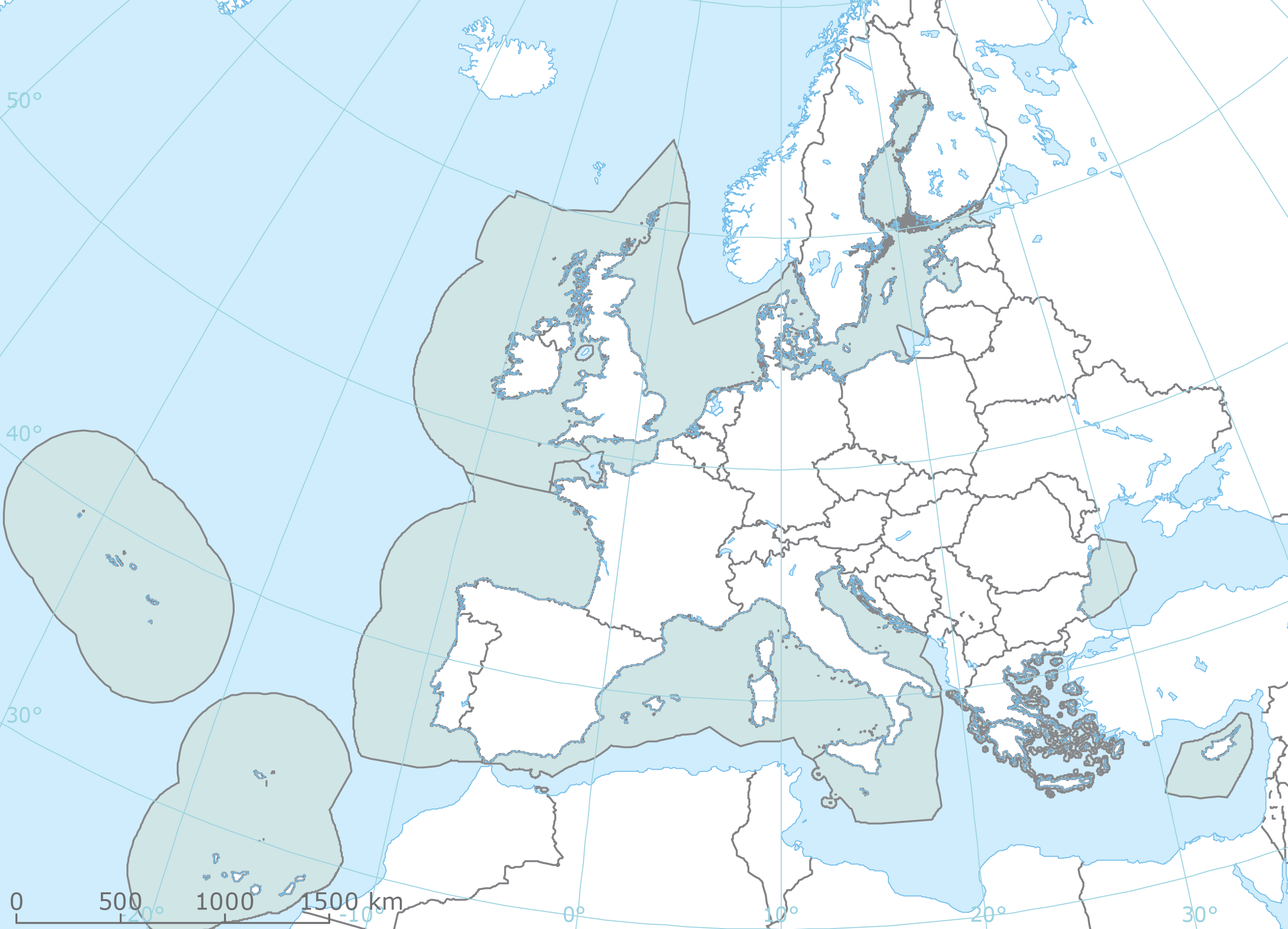
The spatial extent of the MPA assessment areas was defined as the marine waters surrounding the EU countries whose outer limit is defined by the 200 NM boundary from the coast (possibly coinciding with formally recognised EEZ boundaries) or the equidistance (in cases of opposite neighbouring EU countries), or by the presence of a boundary defined by an agreed treaty. Given no formal boundary of this map exists and since this limit coincides with the boundary of the maritime area (water column) submitted by EU Member States under MSFD, this dataset was based on a MSFD Region/Subregion boundary shapefile assembled in 2013 by ETC/ICM integrated with the Maritime Boundaries (version 7) from the Flanders Marine Institute (VLIZ). This dataset has been used to create the map that shows the percentage marine protected area (MPA) coverage in Europe's regional seas and also the distance to the Convention on Biological Diversity Aichi target 11.
-
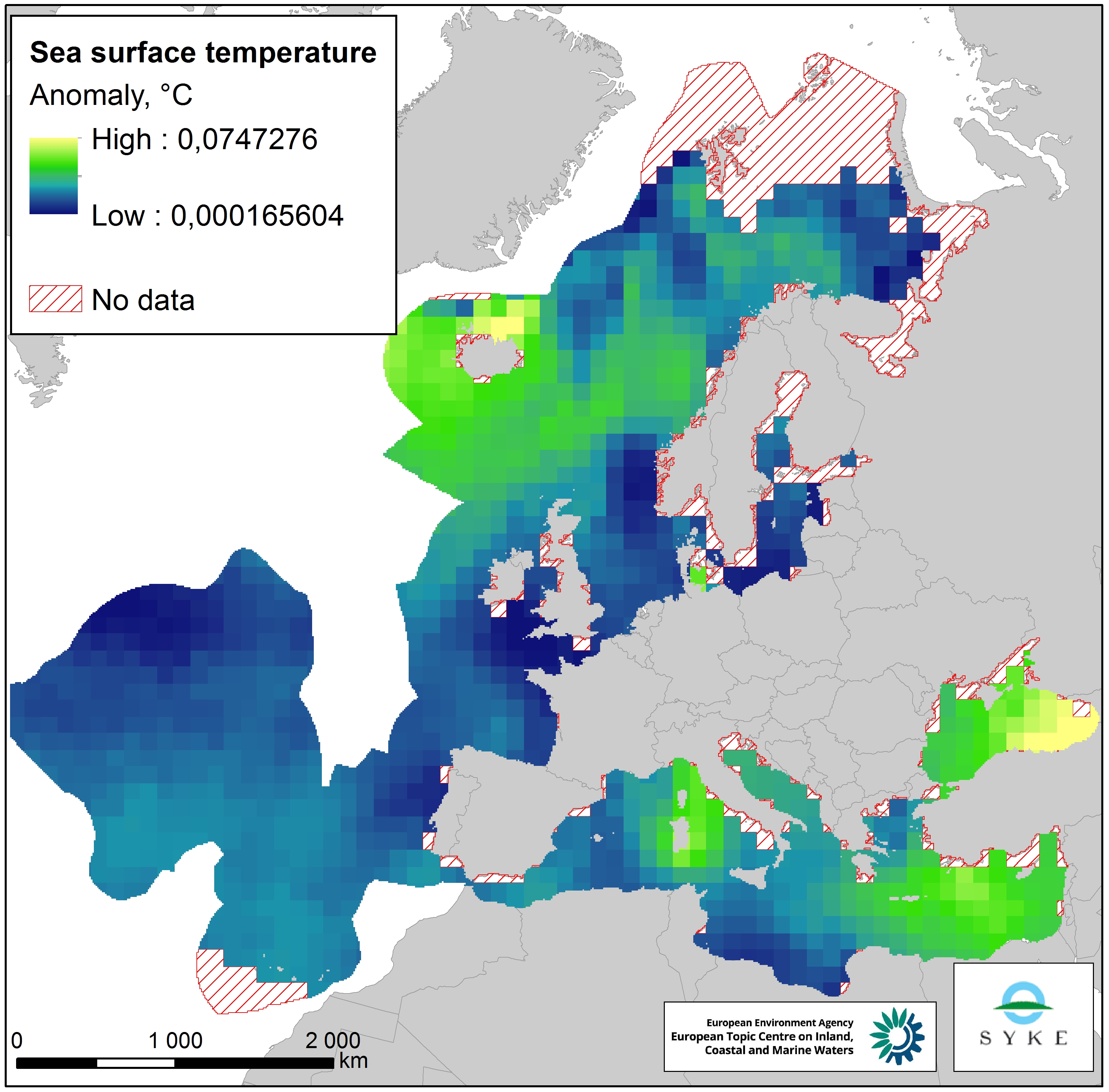
This raster dataset represents the Sea Surface Temperature (SST) anomalies, i.e. changes of sea temperatures, in the European Seas. The dataset is based on the map "Mean annual sea surface temperature trend in European seas" by Istituto Nazionale di Geofisica e Vulcanologia (INGV), which depicts the linear trend in sea surface temperature (in °C/yr) for the European seas over the past 25 years (1989-2013). Since all changes of sea temperatures can be considered to have an impact on the marine environment, the pressure layer includes absolute values of SST anomalies, i.e. negative/decreasing temperature trends were changed to positive values so that they represent a pressure. The original data was in a 1° grid format but was converted to a 100 km resolution, adapted to the EEA 10 km grid and clipped with the area of interest. This dataset has been prepared for the calculation of the combined effect index, produced for the ETC/ICM Report 4/2019 "Multiple pressures and their combined effects in Europe's seas" available on: https://www.eionet.europa.eu/etcs/etc-icm/etc-icm-report-4-2019-multiple-pressures-and-their-combined-effects-in-europes-seas-1.
-
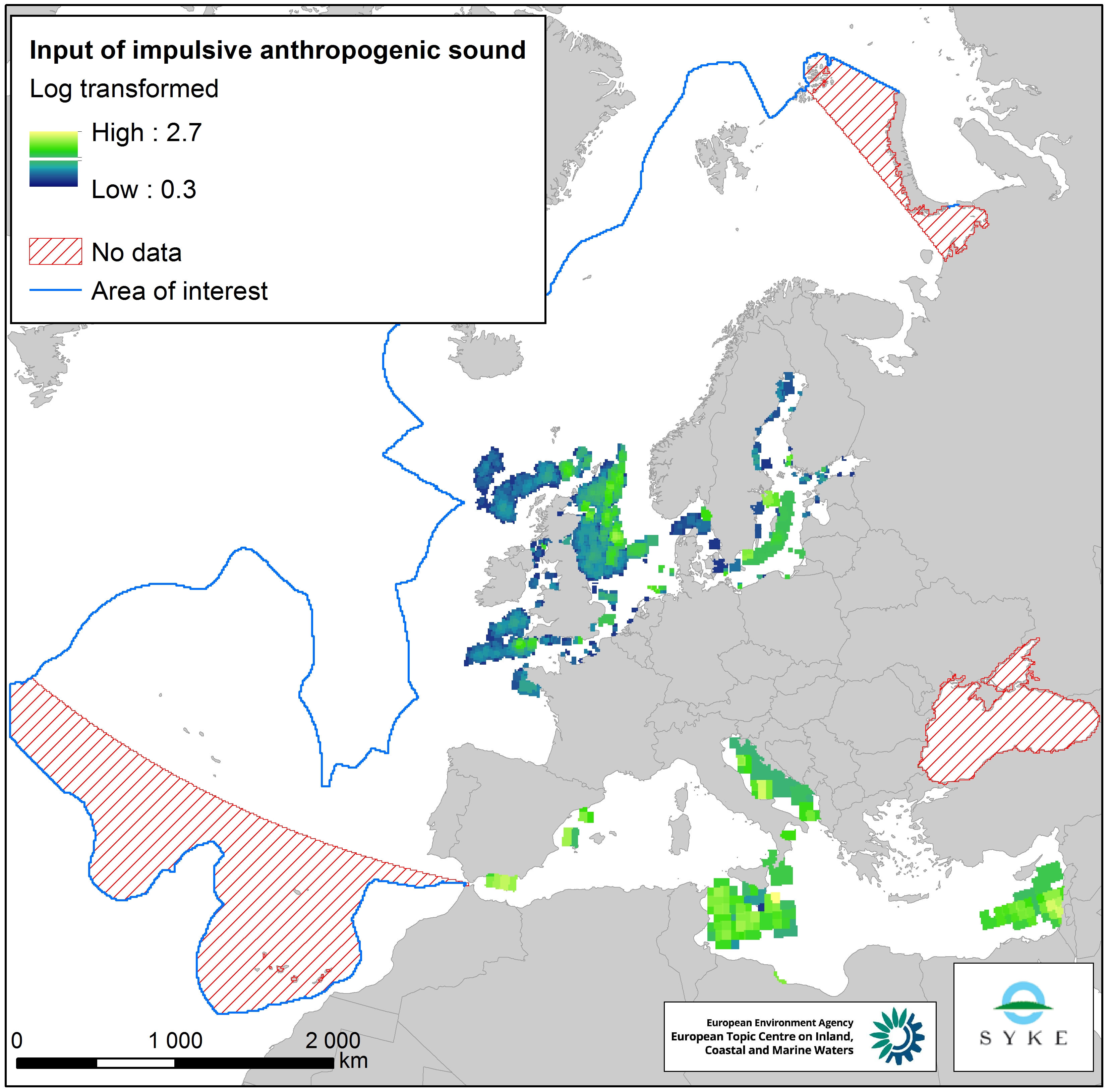
This raster dataset represents input of impulsive anthropogenic sound in Europe Seas. Impulsive sounds are typically brief with a rapid rise time, i.e. a great change in amplitude over a short period of time. The main anthropogenic sources of impulsive underwater noise are typically impact pile driving for inshore and offshore construction, seismic exploration with airguns, explosions and sonar systems. The dataset was created by combining pulse-block-days (PBD) data from the ICES Registry (for HELCOM and OSPAR areas) and ACCOMBAS (for the Mediterranean Sea), resampled using the EEA 10 km grid. The dataset does not include the Black Sea. The temporal reference of this dataset is the period 2014-2016. The cell values have been transformed into a logarithmic scale (log10). This dataset has been prepared for the calculation of the combined effect index, produced for the ETC/ICM Report 4/2019 "Multiple pressures and their combined effects in Europe's seas" available on: https://www.eionet.europa.eu/etcs/etc-icm/etc-icm-report-4-2019-multiple-pressures-and-their-combined-effects-in-europes-seas-1.
 RUC Geo-Data catalogue
RUC Geo-Data catalogue